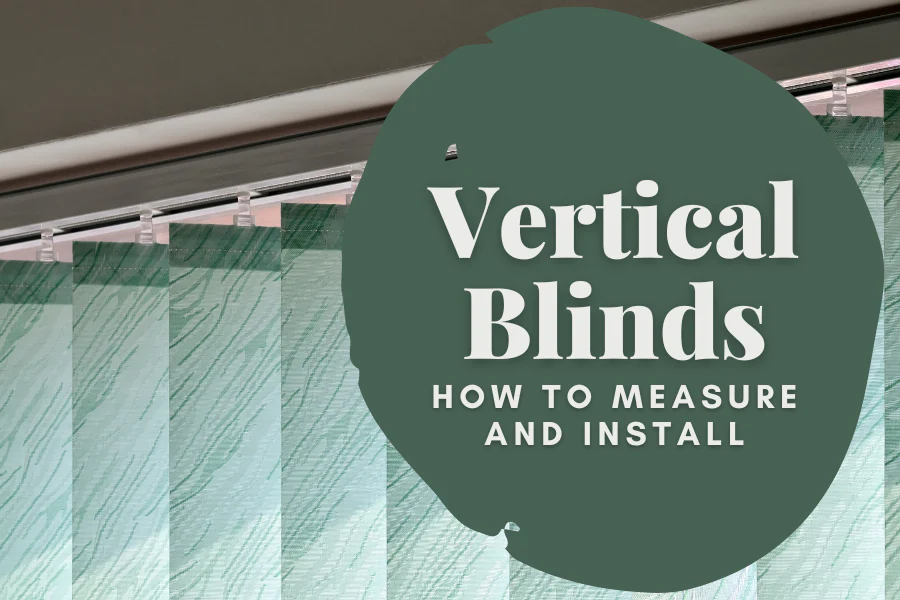Windows are the one of the most important parts of the home. They increase the beauty and elegance of the house. They also provide a beautiful and pleasant outside view. But sometimes, a blockage from windows is required to either control the entrance of strong sunlight or to protect privacy from the outside world. For that purpose, window blinds or curtains can be used. There are various types of window blinds available in the market. One of these types of blinds is vertical blinds.
If you are wondering how to measure windows for vertical blinds, then we are here to help. Accurate measurement is critical when installing vertical blinds. Properly measured blinds ensure a perfect fit, complementing the overall style of the room while providing optimal functionality. Blinds that don’t fit well can leave gaps, letting in too much light and reducing privacy.

Issues like improper alignment or difficulty opening and closing the blinds may arise without correct dimensions. This affects not only the visual appeal of the space but also the usability and durability of the blinds over time.
Let us help you with a few things about measuring the windows for vertical blinds. These things include tools required for measurement, how to take exact measurements, and how to determine whether it is an inside or outside mount.
Tools Required for Measuring
The first thing needed for measurement is metal measurement tape. It is required to take exact measurements. Metal measurement tape is more reliable and accurate than fabric measurement tape.

Furthermore, a notepad and pen are required to note down the measurements of the windows. A step ladder or step stool is needed in case the windows are large, and measurements have to be taken at the top.
Step-by-Step Guide for Measuring Windows
In order to install vertical blinds correctly, follow these steps to take the exact measurements:
Step-1: Determine the Mounting Style
The vertical blinds can face any direction, whether they are outside mounted or inside mounted. In either case, measure the heights and widths of the windows, taking into account any hurdles and obstructions.
The inside mount installation provides a sleek and seamless look. It facilitates maximum privacy and light blockage, making it ideal for bedrooms.
On the other hand, outward-facing blinds provide a different aesthetic, allowing light to filter through while still maintaining some level of privacy. Outward-mounted vertical blinds create the illusion of larger windows. They also offer better light blockage.
If it can not be determined whether an inside or outside mount is required, then it is better to take the help of a professional service or retailer.
Step-2: Taking the Measurements for Both Styles
Measuring for Inside Mount
Measure the width of the window for inside-mount vertical blinds at three positions: top, middle, and bottom. Note down all these measurements. Then, take into account the width that is the smallest.
Measure the height of the window for inside-mount vertical blinds at three positions: left, middle, and right. Note down all the measurements. Then, take into account the height that is the largest.

Make sure that the depth of the window is sufficient enough to handle the blind’s hardware. Check the minimum required depth for the blind to be ordered. If the installation of the headrail of the vertical blind is to be completely in the window frame, then check the flush mount depth requirement of that specific vertical blind. After all the considerations, measure the depth of the window from the front to the opening of the glass.
Finally, order the vertical blinds with the above-mentioned measurements indicating that these measurements are for the inside mount vertical blinds. It is important to note that the vendor will make a small deduction in the widths to accommodate the Blind’s brackets.
Measuring for Outside Mount
For the outside mount vertical blinds, first measure the width of the window opening. Note down the width. Then add three to four inches to the noted widths for better light control and privacy.
Measure the height of the outside mount vertical blinds from the point where the headrail is to be installed to the bottom window edge. Note down the height. Then add a further three to four inches to the height to consider the same for the mounting brackets. If touching of blinds to the floor is expected, cut from the height a half-inch to ensure smooth functioning and operation.
Step-3: Double-Check Measurements
To ensure consistency and correctness, it is a good practice to take measurements at least two to three times and note them down. Ensure that there are no hurdles or obstructions in the path of the blinds so that they can operate smoothly.
Common Mistakes While Measuring
Some common mistakes that usually occur during the measurements and their solutions are described below:
- One of the most common mistakes is using measurement tools like fabric tapes or rulers. The fabric tapes are inaccurate because they are stretchable and can give incorrect measurements, which can result in difficulties while installing the blinds. Also, the rulers cannot be used for longer measurements. Instead, use steel tape which gives the most accurate result.
- Another common mistake while taking measurements is taking them only once. This is considered a mistake because windows are usually not perfectly square, so one-time measurements are inaccurate. Instead, take measurements at least two to three times to get the most accurate reading.
- Ignoring the obstructions is another big mistake. This is considered a mistake because if these obstructions are not considered, the blinds will not open or close properly. To avoid this, take the reading while taking into account these hurdles.
- Another mistake that can occur is measuring for inside-mount vertical blinds while making orders for outside-mount vertical blinds and vice versa. This is considered a mistake because the measurements for the inside-mount and outside-mount vertical blinds are different. First, consider whether inside-mount or outside-mount vertical blinds should be installed to prevent mistakes. Then, take the measurements accordingly.
- Rounding the measurements is another common mistake, which leads to vertical blinds that are too wide, too narrow, too tall, or too short. It can also affect the beauty and aesthetics of the home and windows. To avoid this, always note down the exact measurements and do not round them up.
- Another less common mistake when measuring for blinds is only taking measurements for a single window. This is considered a mistake because although each window looks identical, they may vary in size. The solution to this is to measure each window individually.

Tips for Proper Installation
- Determine the position where a headrail is to be mounted. The mounting position should be 1-3 inches above the window.
- When ordering vertical blinds, consider overlapping each side with window borders by at least 2 inches for better light control and privacy.
- Inside-mount vertical blinds have a half-inch deduction, enabling a proper fit of vertical blinds.
- Standard vertical blinds have a 1.5-inch headrail, while deluxe vertical blinds have a 1.75-inch headrail.
- If the blinds extend to the floor, measure the height from the headrail to the floor. Then, cut a half-inch from the noted height to ensure floor clearance. Floor clearance is the length that ensures the blinds do not touch the ground or floor, thus retaining their beauty.
The Bottom Line
Measuring your windows correctly is the key to getting vertical blinds that look great and work perfectly. It might seem like a small step, but it makes a big difference in ensuring your blinds fit snugly, block out light as needed, and enhance your room’s overall design. A good fit also means fewer headaches, as you won’t have to deal with common issues like gaps or misaligned slats.
By taking the time to measure your windows properly, you’re setting yourself up for a stress-free installation and long-lasting results. It’s a simple effort that pays off big saving you time, money, and the hassle of reordering.
Remember, when it comes to vertical blinds, it’s all about starting strong with the right measurements!

